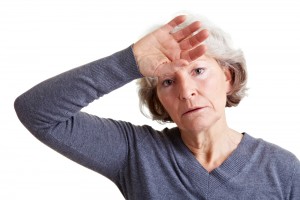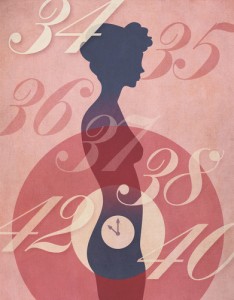
Some of the lady Elves in the forest have been sharing their concerns about the menopause, and whilst keeping an eye out for hot flushes, night sweats and mood swings; what other changes will the menopause will bring?!
Well, Freeman and colleagues have some good news and bad news for us. In November 2013, JAMA Psychiatry published online a series of results from their population based, cohort study: the Penn Ovarian Aging Study (POAS).
Previous information from POAS has shown an increased risk of depression in the years leading up to menopause, with some evidence that changes in reproductive hormones contribute to these symptoms in vulnerable women. Whether this same risk continues in the early postmenopausal years has not really been looked at to date.
Information about the risk of depression in midlife women is clinically important not just because of the morbidity associated with depression but because depression is also associated with other health-limiting conditions that increase in midlife women, such as cardiovascular disease, metabolic syndrome, and osteoporosis.
The POAS study aimed to look at within-woman changes in depressive symptoms during a 14-year period around natural menopause. They hypothesized that, relative to menopause, the risk of high depressive symptoms increased in the years before menopause and decreased in the years after menopause.

The menopause is about more than just hot flushes, night sweats and mood swings!
Methods
The POAS cohort was randomly identified by telephone digit dialing to households in Philadelphia County, Pennsylvania, and sampling was stratified to obtain equal numbers of African American and white women. All cohort participants were premenopausal at enrollment as defined by regular menstrual cycles in the reference range (22-35 days for the previous 3 menstrual cycles), were aged 35 to 48 years, and had an intact uterus and at least 1 ovary.
Exclusion criteria included current use of any hormone or psychotropic medication, alcohol or drug abuse, major psychiatric disorder in the past year, pregnancy or breastfeeding, serious health problems known to compromise ovarian function, or uncontrolled hypertension.
Follow-up assessments were conducted for 14 years at intervals of approximately 9 months in the first 5 years and then annually, with a 2-year gap between assessments 10 and 11.
The primary outcome measure used for depressed mood was the Center for Epidemiologic Studies Depression Scale (CES-D), a standard measure that evaluates current depressive symptoms in the past week.
The group also looked at the association between a history of depression and the pattern of depressive symptoms, age at menopause, race, body mass index, and current smoking as possible modifiers of the depressive symptoms; and identified the within-woman rate of change of reproductive hormones (estradiol, follicle-stimulating hormone [FSH], and inhibin B) in the years leading to menopause as predictors of depressive symptoms in the early postmenopausal years.
Results
In total, 203 participants were followed up for 14 years and contributed a mean of 12.4 CES-D observations per woman.
- The mean age was 42.8 years at baseline and 51.1 years at the final menstrual period (FMP) (range, 42-58 years), 47.3% were African American and 52.7% white, and 44.3% had a history of depression at cohort enrollment.
- The overall prevalence of high CES-D scores decreased from 10 years before to 8 years after the FMP, with an overall decrease of approximately 15% per year.
- Women with a history of depression were more than 13 times more likely to have high depressive symptoms compared with women with no history of depression
- Depressive symptoms were approximately 50% more likely after the first 2 years after menopause than in subsequent years
- Race, age at menopause, and body mass index were not significantly associated with CES-D scores
- Women who had a history of depression were 8 times more likely to have depressive symptoms after menopause than women who had no depression before the FMP
- Women whose first depressive symptoms occurred in the study had no significantly greater likelihood of depressive symptoms after menopause than women who had no depression.
- When risk was compared with the FMP, the risk of depressive symptoms was higher in each year before and lower in each year after the FMP.
The researchers estimated the rate of change in FSH, estradiol, and inhibin B before the FMP as predictors of depressive symptoms after menopause. The risk of depressive symptoms after the FMP decreased by 35% for each unit (SD) increase before the FMP in log rate of change of FSH. There was no significant association between the rate of change of estradiol or inhibin B and depressive symptoms after FMP.
Conclusions
This study has identified a longitudinal pattern of depressive symptoms around natural menopause that showed symptoms decreased steadily from approximately 10 years before to 8 years after the FMP.
The final menstrual period (FMP) was pivotal in this pattern, with a higher risk of depressive symptoms before the FMP and a lower risk of depressive symptoms after the FMP.
This suggests that a risk of depressive symptoms for the group who first experienced the symptoms in the menopause transition continued for several years after the FMP but then sharply decreased, with a likelihood of depressive symptoms that was not significantly greater than the risk for women who had no depressive symptoms before menopause.
Limitations
Several limitations are noted:
- Depressive episodes are often time limited and may not have been fully identified at annual evaluations.
- The CES-D, with a cut point at 16 and higher, is a standard measure of depressive symptoms and may not indicate a clinical diagnosis of depressive disorder, although it is noteworthy that results were similar with a higher cut point of 25 or more.
- To extend interpretations of these findings, the group are investigating longitudinal patterns of sleep disturbance and vasomotor symptoms to evaluate their joint relationships with depression.
- Finally, studies are needed to extend or refute these findings of a decreased risk of depression after menopause, particularly for women who had no history of depression before the menopause transition.
Take home message
Women overall can expect depressive symptoms to decrease after their final menstrual period (FMP), although those with a history of depression have a continuing high risk of recurrence.
Women whose first experience of depressive symptoms occurred as they approached menopause can however expect a low risk of depressive symptoms after the second year following menopause.
Links
Freeman EW, Sammel MD, Boorman DW, Zhang R. Longitudinal Pattern of Depressive Symptoms Around Natural Menopause. JAMA Psychiatry. 2014;71(1):36-43




Mine hasn’t been! but then I was diagnosed with a life threatening condition as I started and my focus to survive and beat the illness seems to have made my symptoms tiny, get the sweats, whiskers on chin, skin dryness…..but thankfully no mood swings.
Is the menopause depressing? Not necessarily: Some of the lady Elves in the forest have been sharing their con… http://t.co/J5VSkKXaAI
@Mental_Elf: says ‘Is the menopause depressing? Not necessarily http://t.co/kge0rjeuT1‘
Mental Elf: Is the menopause depressing? Not necessarily http://t.co/4RjK7TtGw4
@LiaisonLawson summarises a US cohort study looking at rates of #depression before, during and after #menopause http://t.co/w5MhEIaIOb
Is the menopause depressing? Not necessarily, writes @LiaisonLawson http://t.co/2WuratUAiv
Is the menopause depressing? Not necessarily. – The Mental Elf http://t.co/d5qKGLW4jw
The POAS study shows that depression symptoms are reduced from before to after menopause http://t.co/w5MhEIaIOb
Depression decreased from 10 years before to 8 years after the final menstrual period http://t.co/w5MhEIaIOb
In menopause, women w/ history of depression >13 times more likely to have severe depression than women w/ no history http://t.co/w5MhEIaIOb
@Mental_Elf oh dear it’s HRT for ever them for me, not to mention continuing the venlafaxine and the lithium. Back to neurobabble . .
The menopause is about more than just hot flushes, night sweats & mood swings http://t.co/w5MhEIaIOb
@Mental_Elf ‘Depressive symptoms were approx 50% more likely after first 2 yrs after menopause than subsequent yrs’ Why did no one tell me?
@LiaisonLawson on a @JAMAPsych study about the longitudinal pattern of depressive symptoms around natural menopause http://t.co/w5MhEIaIOb
@NAMSnews @menomatters Interested in your thoughts on our blog about menopause and depression http://t.co/w5MhEIaIOb
RT @Mental_Elf: The risk of depression reduces after menopause http://t.co/w5MhEIaIOb
Don’t miss: Is the menopause depressing? Not necessarily http://t.co/w5MhEIaIOb by @LiaisonLawson
@Mental_Elf @LiaisonLawson the good news is we’ve reached menopause?
Our resident DJ @LiaisonLawson is rocking the woodland wheels of steel today with Don’t Stop by Fleetwood Mac http://t.co/w5MhEIaIOb
Psychiatrist @LiaisonLawson blogs about depression and the menopause http://t.co/w5MhEIaIOb
http://t.co/qZh8R6PUjO